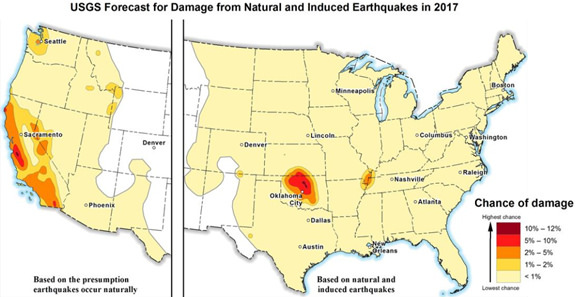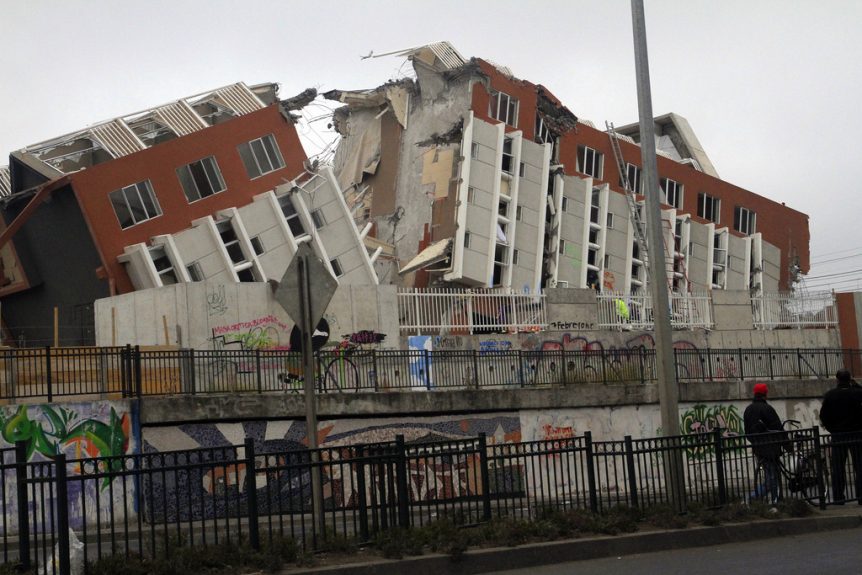Earthquakes
Earthquakes catastrophically shake the ground upon which we inhabit. The rapid shifting of subterranean rock deep underneath the earth’s surface causes earthquakes of varying magnitudes. Subsequent to the actual earthquake, which typically lasts for a minute or two, are aftershocks. Most aftershocks are relatively minor, with very few being major. Aftershocks can last anywhere from a few hours to several months.
When the earth’s surface shifts during earthquakes, major damage occurs. Roads are uplifted. Residential and business property foundations are dislodged or may even collapse entirely. Fires and explosions are likely during an earthquake. Not only are structural buildings affected, but natural disasters occur. Earthquakes are known to cause tsunamis, landslides and avalanches.
Smaller quakes can cause chaos within a home. Books, china and vases fall out of shelves, causing injury to anyone underneath. Kitchen cupboards neatly packed with fragile dinnerware can abruptly open during the earthquake, flinging out the plates and saucers and dashing them to the ground.
In the United States, all 50 states are at risk for experiencing some degree of earthquakes. Certain identified seismic zones produce a higher frequency of earthquakes, such as areas along the west coast, the east coast and fault zones along the south.

Those who live in earthquake-prone areas are best off preparing in advance for when an earthquake hits. Certain safety precautions are recommended before, during and after an earthquake. Your personal safety is of utmost importance when the earthquake strikes. By being prepared, you can limit the destruction to your home and community in the event of an earthquake – and keep yourself and loved ones as safe as possible.
Earthquake-proof Your Home
Your area has been struck with earthquakes in the past. You know that the earth’s shifting will occur again. How do you prepare? Bookshelves, mirrors, home electronics and fixtures are all items that can fall and cause injury. Secure items, like bookshelves, against the wall with sturdy bolts. Attach latches to cupboards so fragile dishes don’t fly out and cause injury when an earthquake strikes. Strap your water heater to the wall. Move any items hanging over cribs, beds or sofas to areas where people do not lie or sit. Double check that all gas appliances are installed with flexible connectors. These precautionary measures should be immediately put into place in order to ensure your home or business is as earthquake-proof as possible and to limit an unpredictable earthquake’s damage.
Keep three days’ worth of canned food and water in an accessible place. Plan a safety route with your loved ones in the event a quake hits. Make sure to communicate with your loved ones, keeping and sharing a contact list of addresses and phone numbers, as well as evacuation sites. Performing safety drills with your family is one of the most effective ways to be prepared.
Should you own your home in an earthquake-prone area, professionals can help you identify and solve trouble spots. Specialists can locate structurally weak points in your foundation that make them especially vulnerable to earthquakes. If you rent, ask what actions have been taken to protect the vicinity and to make sure it abides by local building codes.
In the Middle of a Quake
When you are located within a building when the quake strikes, immediately move to an area where items cannot fall on you. Such safe areas include underneath a sturdy table or next to an interior wall. Drop to the ground immediately upon feeling the tremors. Doing so will prevent the earthquake from first jolting you and causing you to lose your balance. Once upon your knees, cover your neck and head with your arms or pillow to protect yourself from falling debris. Crawl away from glass, like windows, mirrors or light fixtures, and anything that can shatter. Do not go outside. Remain inside, as close to the ground as possible, until the shaking stops.
If you are outside when the earthquake hits, remain calm. Stay away from buildings, utility wires and streetlights that can shatter and fall. Get out into the open and drop to the ground until the quake stops. If you are in a car, stop as quickly and safely as you can in an open area. Do not stop your vehicle under a bridge, building, tree or overpass, as these structures can fracture and fall in an earthquake.
In the Aftermath of a Quake
When the earthquake’s shakes subside, be prepared for sudden aftershocks. Remember, these minor shakes can continue for hours up to several months after the initial quake.
Check for injuries among your loved ones and yourself. Administer first aid where necessary. Use your cell phone to call for help.
Take care of your home after a quake. This means temporarily turn off your water supply if broken pipes result from the earthquake. Shut off the electricity and natural gas if you notice frayed wires or leaking gas. Ultimately, if your home is too much of a risk to occupy due to structural damage, you may need to seek emergency shelter with the American Red Cross.
If your home is destroyed, take steps to rebuild your property with the help of a professional disaster restoration and recovery team, like San Francisco’s ServiceMaster DRR. A crew of handymen, contractors and subcontractors will work to restore your home to its original condition prior to the earthquake. Specialists from ServiceMaster DRR will also ensure your property is secured and stabilized to prevent any risk of accident that may result from structural harm caused by the quake.
ServiceMaster Restore – Services – Watch the Video
Disaster restoration teams offer services to make living in your home safe once again. These services include, but are not limited to, plumbing and electrical work, roof repair, remodeling and full service general contracting.
When an earthquake strikes, you’re not alone. Resources are available to help you get back to your everyday life. However, be smart and stay prepared in the event of the next earthquake.
Sources:
www.fema.gov
www.nationalgeographic.com
www.ready.gov

Steve VanDenBerg is the owner of ServiceMaster Disaster Restoration and Recovery. He has over 30 years of experience working within the restoration industry and successfully leading start-ups, turnarounds, acquisitions and mergers, and rapidly growing companies.
Steve earned his BS in Business & Accounting from Calvin University in Grand Rapids, MI and began working for DSI Holdings as their Chief Financial Officer. When Steve began with DSI Holdings, they were running an underperforming ServiceMaster Restore franchise with one location. Steve implemented new policies and procedures for accounting and finance as well as a professional sales plan that increased profits eightfold over his time as the CFO. He was then promoted to President and CEO and in this time, he expanded the company from two locations with $4M in sales to 12 locations and $45M in sales. DSI Holdings became one of the largest disaster restoration companies in the U.S. and helped with major restoration projects throughout the U.S. and around the world.
Steve purchased ServiceMaster DRR in 2015 when the business was in decline. Drawing on his years of experience in turning around struggling ServiceMaster franchises, Steve overhauled our operations, including finance, sales, and marketing, which led to a quick turnaround. Within Steve’s first 24 months, sales increased by 60 percent. Steve also helped greatly improve our operating margins and established a relationship with California’s largest residential insurance company. Under Steve’s leadership, we have become one of the largest disaster restoration providers in California.
Steve has found great success in turning around struggling and stagnant restoration franchises by changing the business model and strategy, greatly increasing sales and profits. Many of the changes he has implemented have even been adopted by the franchisor into their operating model.



